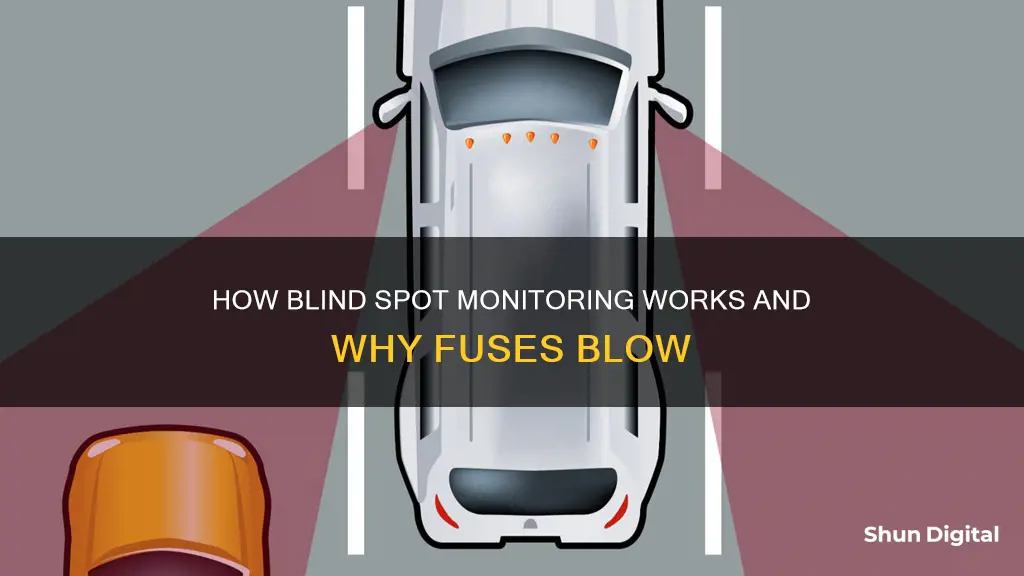
Blind-spot monitoring is a useful feature in vehicles that helps drivers change lanes safely by alerting them to the presence of other vehicles in their blind spots. While this technology is generally reliable, issues can sometimes arise, such as errors with warning lights, sensors, and modules. In some cases, these problems may be caused by faulty fuses, and it is recommended to inspect and replace them if necessary. However, other potential causes include dirty or obstructed sensors, water damage, and loose connections. Diagnosing and resolving blind-spot monitoring issues may involve checking fuses, cleaning sensors, disconnecting batteries, and seeking assistance from dealerships or forums.
What You'll Learn
- A fuse issue can cause the blind spot monitoring system to fail
- The blind spot monitoring system can be fixed by replacing the module
- The blind spot monitoring system's sensor is located in the rear bumper
- The blind spot monitoring system's fuse is located in the engine bay
- The blind spot monitoring system can be affected by dirt or water

A fuse issue can cause the blind spot monitoring system to fail
Fuses are an essential safety feature in any electrical system, including those found in vehicles. They are designed to protect the circuit from overload or short circuits. When an electrical circuit draws more current than it is designed to handle, it can overheat and potentially cause a fire. Fuses contain a small piece of metal that melts when exposed to high current, interrupting the flow of electricity and preventing a hazardous situation.
In the context of a blind spot monitoring system, a fuse plays a critical role in ensuring the system's proper functioning. These systems rely on sensors, cameras, and other electrical components to detect vehicles in the driver's blind spot and provide warnings to the driver. If the fuse associated with the blind spot monitoring system blows, it can disrupt the flow of electricity to these components, causing them to malfunction or stop working altogether.
For example, in some Chevrolet models, fuse #62 is associated with the blind spot detection system. If this fuse blows, it can cause the system to malfunction, as described by a user on a Chevrolet forum. They noticed that the blind-spot detection light on their mirror lit up continuously, even when the car was turned off. By removing the fuse, they were able to temporarily resolve the issue, but the problem persisted, indicating a potential fault within the system.
Similarly, a user with a 2014 Toyota Tundra experienced an issue with their blind spot monitoring system, where the light on the switch stopped turning on. They suspected a fuse issue and checked the fuse box in the engine bay, as suggested by another user. However, it is unclear whether resolving the fuse issue solved the problem in this case.
It is important to note that a blown fuse may not always be the root cause of a blind spot monitoring system failure. Other factors such as sensor damage, software malfunctions, physical damage, or corrosion can also contribute to system malfunctions. Therefore, it is advisable to consult a professional mechanic or dealer to accurately diagnose and resolve any issues with the blind spot monitoring system.
Blind Spot Monitor Mirrors for 2010 Toyota Tundras: A Safety Upgrade
You may want to see also

The blind spot monitoring system can be fixed by replacing the module
The blind spot monitoring system is an essential safety feature in vehicles, and issues with this system should be addressed promptly. In some cases, the blind spot monitoring system can be fixed by replacing the module. This solution has been effective for certain car models, including the Chevrolet Impala and the Golf GTI.
For the Impala, the issue was traced to a faulty module, which was replaced with an updated version, resolving the problem. However, it's important to note that programming at the dealer was required after installing the new module. Similarly, for the Golf GTI, the problem was diagnosed as an error with the "warning lamp in the left ext. mirror," and the solution involved replacing the module.
In addition to module replacement, there are other potential fixes for blind spot monitoring systems. For instance, some issues may be caused by dirty or malfunctioning sensors, which can be cleaned or repaired. It's also worth checking for any loose or damaged wiring, as this can impact the system's functionality.
If you're experiencing problems with your blind spot monitoring system, it's recommended to consult a professional or refer to your vehicle's owner's manual for specific instructions and safety precautions. Self-diagnosis and repairs can be complex and may void warranties if not performed correctly.
Aftermarket blind spot monitoring systems are also available, which can be installed by professionals or, in some cases, by the vehicle owner. These systems typically include sensors, indicators, and other components that work together to alert drivers of potential hazards. However, it's important to note that even with a blind spot monitoring system, drivers should remain cautious and continue using their mirrors and checking their blind spots manually.
Troubleshooting an ASUS Monitor: 144Hz to 60Hz
You may want to see also

The blind spot monitoring system's sensor is located in the rear bumper
Blind-spot monitoring systems are vehicle-based sensor devices that detect other vehicles located in the driver's rear blind spots. These systems can alert the driver of vehicles and obstacles through visual, audible, vibrating, or tactile warnings. While the side-view mirrors on a car can be adjusted to eliminate blind spots, this method is frequently overlooked in driver's education and takes some getting used to.
The blind-spot monitoring system's sensor is located in the rear bumper. This sensor uses radar technology to detect objects in the vehicle's rear blind spot. If you are experiencing issues with your blind-spot monitoring system, it could be due to a problem with the sensor being covered or damaged. Checking the sensor for any dirt, mud, or ice build-up is a good first step in troubleshooting.
In some cases, issues with the blind-spot monitoring system may be related to a fuse. However, it is important to note that simply removing or replacing a fuse may not fix the problem. If you are experiencing continuous issues with your blind-spot detection light, it is recommended to consult a professional or refer to your vehicle's owner's manual for specific instructions.
Additionally, some vehicles may have the sensor located in the side mirrors or door mirror housings. It is important to refer to your vehicle's specifications to determine the exact location of the blind-spot monitoring system's sensor.
LCD Monitors and Radiation: Is There a Risk?
You may want to see also

The blind spot monitoring system's fuse is located in the engine bay
The blind spot monitoring system is an important feature of modern cars, and like any other electrical component, it relies on a fuse to function. When the blind spot monitoring system fuse blows, the system will not work, and a warning light may illuminate on the dashboard. In some cases, the system may exhibit erratic behaviour before failing completely.
If the blind spot monitoring system is not working, the first step is to check the fuse. The location of the fuse box varies depending on the car model. In some cars, the fuse box is located in the engine bay, while in others, it may be found inside the car, either under the steering wheel or in the glove compartment. Referring to the car's owner's manual can help identify the location of the fuse box and the specific fuse for the blind spot monitoring system.
Once the fuse box is located, the next step is to identify the fuse for the blind spot monitoring system. The fuse will be labelled with a number or a description, making it easier to identify. In some cases, the fuse may be labelled specifically for the blind spot monitoring system, while in others, it may be part of a larger electrical system.
If the fuse for the blind spot monitoring system is blown, it will need to be replaced. It is important to use a fuse with the correct amperage rating. Replacing a fuse with a higher amperage rating can be dangerous and may lead to electrical problems or even fires. Once the new fuse is installed, the blind spot monitoring system should be operational again.
In some cases, a blown fuse may indicate a more serious problem with the blind spot monitoring system. For example, a short circuit in the wiring or a faulty sensor could have caused the fuse to blow. If the fuse blows again after replacement, further diagnostics may be required to identify the root cause of the problem.
Ultimate Monitor Guide: HP 2311x Size Explained
You may want to see also

The blind spot monitoring system can be affected by dirt or water
The blind spot monitoring system is an advanced driving assistance system (ADAS) designed to increase safety by alerting the driver to vehicles that may be in their blind spots. The system uses radar or ultrasonic sensors located inside the left and right sides of the rear bumpers, as well as cameras in the side-view mirror housings, to detect vehicles within monitored areas.
In addition, water ingress into the sensors or camera lenses can cause electrical issues, such as short circuits, which can render the system inoperable. This is a particular concern if the sensors or cameras are not properly sealed or protected from the elements. For example, water entering the side-view mirror housing can cause the LED lights or the entire mirror assembly to malfunction.
Therefore, it is important to ensure that the sensors and camera lenses are clean and free of obstructions to maintain the proper function of the blind spot monitoring system. This may involve regular cleaning or inspection, especially after driving in dirty or wet conditions.
Replacing the LCD Monitor Cable on Your Asus Q502LA
You may want to see also
Frequently asked questions
Check the fuse box in the engine bay. If the fuse is blown, replace it. If the fuse is not blown, the problem may be with the blind spot monitoring sensor or the wiring.
Check the sensor for dirt or damage. If the sensor is dirty, clean it. If the sensor is damaged, replace it.
The blind spot monitoring system warning light may stay on continuously or flash. The system may also fail to detect objects in the blind spot.
Common causes of blind spot monitoring system failure include a blown fuse, a dirty or faulty sensor, faulty wiring, or a problem with the control unit.







